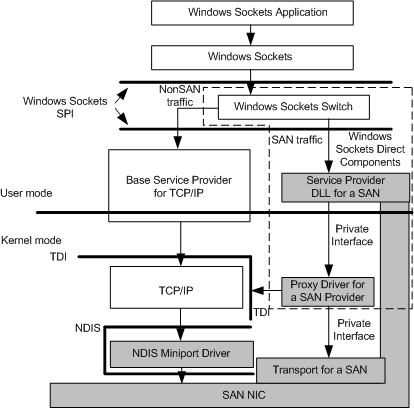Introduction to System Area Networks
A system area network (SAN) is a high-performance, connection-oriented network that can link a cluster of computers. A SAN delivers high bandwidth (1 Gbps or greater) with low latency. A SAN is typically switched by hubs that support eight or more nodes. The cable lengths between nodes on a SAN range from a few meters to a few kilometers.
Unlike existing network technologies such as Ethernet and ATM, a SAN offers a reliable transport service; that is, a SAN guarantees to deliver uncorrupted data in the same order in which it was sent. Connection endpoints in a SAN are not required to use the TCP/IP protocol stack to transfer data unless traffic must be routed between subnets. SAN-local communication can use a native SAN transport, bypassing the TCP/IP protocol stack.
A SAN network interface controller (NIC), a transport driver for the SAN NIC, or a combination of both exposes a private transport interface. However, because most networking applications are written to use TCP/IP through Windows Sockets, they cannot use a SAN directly. The Windows Sockets Direct components shown in the following figure let these applications benefit from using a SAN transparently without requiring modification. Windows Sockets Direct is part of:
Microsoft Windows 2000 Datacenter Server
Microsoft Windows 2000 Advanced Server SP2
Microsoft Windows 2000 Server Appliance Kit SP2
Microsoft Windows Server 2003
The following figure shows the architecture required to support a SAN. The shaded areas represent components that a SAN NIC vendor supplies to enable using a SAN.

The following is a description of the components shown in this figure.
Windows Sockets application
Application that interfaces with Windows Sockets for network services.
Windows Sockets
The Windows Sockets interface (Ws2_32.dll).
Windows Sockets SPI
The Windows Sockets service provider interface (SPI).
Windows Sockets switch
The Windows Sockets switches between use of the standard TCP/IP service provider and particular SAN service providers.
TCP/IP service provider
A user-mode DLL and associated kernel-mode proxy driver that comprise the standard base Windows Sockets service provider for TCP/IP. The proxy driver exposes a TDI interface.
TCP/IP
The standard TCP/IP protocol driver.
SAN service provider
The user-mode DLL portion of the SAN service provider.
Proxy driver for a SAN service provider
The kernel-mode proxy driver of the SAN service provider.
NDIS miniport driver
The NDIS miniport driver that supports communication to the SAN NIC using the standard TCP/IP protocol driver.
SAN transport
A reliable transport service, which can be fully implemented in the NIC, fully implemented in software, or implemented in a combination of both hardware and software.
SAN NIC
The physical SAN network interface controller (NIC).
A kernel-mode provider for a particular SAN. (Reserved for future use.)
Supporting System Area Networks
Using a SAN with Windows Sockets Applications